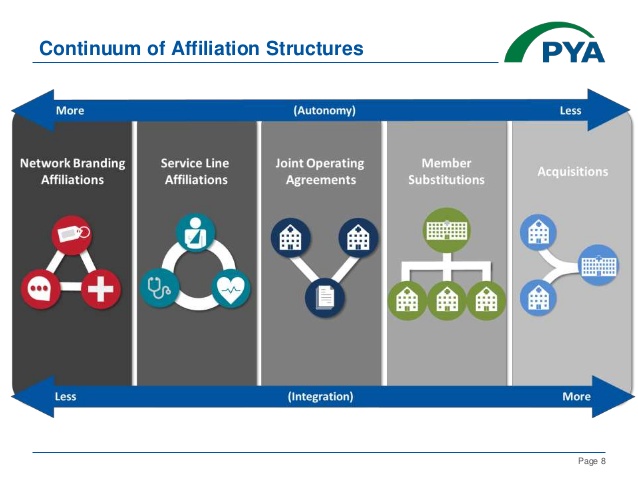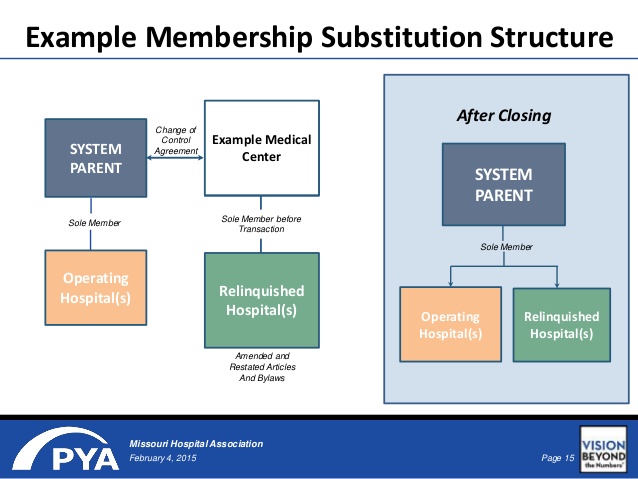
From the PYA chart above you can see that a “Member Substitution” would potentially provide more autonomy for IRMC than an “Acquisition,” and a Member Substitution has less integration than an Acquisition.
(PYA is a nation-wide leader in healthcare consulting, audit & accounting, assurance, tax and business compliance.)
A committee made up of trustees of the Indian River Medical Center (IRMC), the Indian River Medical Center Foundation and the Indian River County Hospital District have been meeting to find a “partner” to insure IRCMC’s financial future.
On November 17, Juniper Advisory, a specialized Chicago investment banking firm focused exclusively on hospital M&A reported to the committee that, on behalf of the committee, they had approached 33 health systems and that 12 had expressed interest.
Of the 12, eight proposals were reviewed and the committee subsequently selected four systems with which to pursue negotiations.
Three of the four are nonprofit health systems:
- Adventist Health Systems
- Cleveland Clinic
- ORLANDO HEALTH
The for-profit system is HCA, the Hospital Corporation of America.
In non-financial comparison documents comparing the four systems the first line item, even before lease and employees, is “Structure.”
32963 recently reported that two of the nonprofits, Adventist and Cleveland, indicated their structure would be “Membership Substitution.”
And that HCA, the only for-profit, and non-profit Orlando Health indicated their structure would be “Acquisition.”
This has to be one of the key considerations for the committee.
How is a Membership Substitution different than an Acquisition?
Rex Burgdorfer and Alex Voss, with Juniper Advisory in Chicago, the firm representing IRMC and IRCHD, wrote in The Bond Buyer on February 15, 2017 that “Membership Substitution transactions are the most common form of business combination transaction in the nonprofit hospital industry. They are also widely misunderstood and the source of many mistakes.
Given the forecasted level of nonprofit hospital M&A activity in the coming years, as well as the increased use of the membership substitution specifically, it is important that these new and often inexperienced participants consider the implications of the structure.”
A membership substitution model resembles a relationship where a parent company owns a subsidiary with the parent having full control over the subsidiary. IRMC would essentially be a subsidiary of another entity, perhaps with a limited minority number of board seats on the entity’s board.

In a nonprofit to nonprofit membership substitution, usually, a purchase price is rarely paid, instead the seller is relieved of its financial liabilities and secures a commitment to invest capital in the future.
All assets are conveyed to the buyer.
All liabilities should be assumed or guaranteed by the buyer.
Capital expenditures are committed by the buyer for routine and strategic needs in the future.
According to Rex Burgdorfer and Alex Voss of JupiterAdvisory in their The Bond Buyer article referenced above, the membership substitution transaction structure has several advantages:
“It creates successorship for contractual agreements – employment, collective bargaining, management teams and similar operational matters are preserved.
Business operations are uninterrupted – licensures, working capital, and leases are unchanged.
The acquisition process is streamlined – timing and due diligence are simplified, regulatory scrutiny can be eased, and often there is no need for wind down corporation.
Pensions, swaps, and other liabilities continue as a going concern – no need to terminate with the PBGC or unwind costly derivative instruments.
Debt issues – avoid prepayment penalties and defeasance costs associated with today’s low interest rate environment.
No need for tail insurance – beneficial if confronted with Stark or compliance issues that cause such coverage to be unattainable or unduly expensive.”
An “Acquisition” is an acquisition. Wikipedia defines acquisition as “a corporate action in which a company buys most, if not all, of another firm’s ownership stakes to assume control of it.”
It limits the buyer’s legal obligations related to historic operations and typically includes a purchase price and debt being retired or restructured.
An acquisition by a bigger health care system, would be able to financially support a smaller, struggling hospital and the acquiring hospital gets a bigger network that would generate new patients.
On they other hand, since HSA, for example, is a for-profit, it may be seeking to achieve economies of scale more quickly through integration of staff and systems; achieving cost reductions and eliminating non profitable programs.
“Structure” has to be one of key element in considering and finally choosing a partner.
The financial terms of an acquisition might be more beneficial, but a member substitution model may respect the independence of IRMC; as well as taking into account the culture of the subsidiary.
